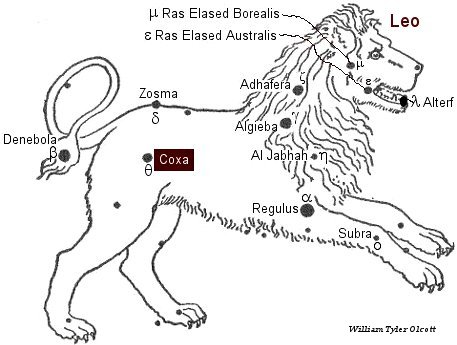| Fixed star: COXA | |
| Constellation: Theta (θ) Leo | |
| Longitude 1900: 12VIR02 | Longitude 2000: 13VIR25 |
| Declination 1900: +15.59′ | Declination 2000: +15.26′ |
| Right ascension: 11h 14m | Latitude: +09.40′ |
| Spectral class: A4 | Magnitude: 3.4 |
The history of the star: Coxa
from p.262 of Star Names, Richard Hinckley Allen, 1889.
[A scanned copy can be viewed on this webpage

Coxa is Latin for “hip”.
Theta (θ Coxa) along with the star delta (δ Zosma) on the hind quarter were Al Kihil al Asad, the “Space between the Shoulders” of the Lion, Leo. The “Two Little Ribs”, or the” two Khurt”, or “Holes”, penetrating into the interior of the Lion [Allen, Star Names, under Zosma].
Theta (θ) Leo, Coxa, with delta (δ Zosma) were the Euphrates’ Kakkab Kua, the constellation of the god Kua, the Oracle [according to this website on the Sumerian language; the word kakkab means “constellation”, and the word kua seems to have three meanings; “fish”, “god”, and “oracle”], and hence according to Noonan (see below) these stars gave the ability to prophesy.
In Egypt, according to Hewitt these stars, theta (θ) Leo, Coxa, with delta (δ Zosma), were Mes-su, the Heart of Su [messu is Egyptian for “anointed one,” from which the word “messiah” comes (source, p.410.). The child Horus was the messu of the inundation. (source, p.525.)].
In Sogdiana (an Iranian people) they were “Wadha, the Wise”:
In Khorasmia, Armagh, the “Great”.
With the Copts (who are now the Christians in Egypt) Pikhorion, the Shoulder.
The Arabic name for Coxa or Chort is Al-Kharat, “The rib”.
Coxa is a star in the manzil (Arabic Moon Mansion) Al Zubrah, shares with delta (δ Zosma) the title Al H-aratan, the Persian astronomer Al Biruni (973-1048 A.D.) saying that “when they rise Suhail (Canopus) is seen in Al Izak,”— wherever this may be. The Century Cyclopedia gives Chort (Arabic for “small rib”) as the individual name, from the combined title. The 15th century Tartar astronomer Ulug Beg substituted the 5th-magnitude Fl. 72 for delta (δ Zosma) as the second member of the manzil (Arabic Moon Mansion), his translator placing them in coxis, “in the hips,” as does the Heis Atlas
In China it was Tsze Seang, the Second Minister of State.
Star Names, Their Lore and Meaning, Richard Hinckley Allen, 1889].
The Lunar Mansions
Delta (δ Zosma) with theta (θ this star Coxa) Leo, on the hind quarter of the Lion, constituted the 9th manzil (Arabic Moon Mansion), Al Zubrah, the Mane, and itself bears this name as Zubra,— strange titles for star and station so far away from that feature of the animal (nowhere near the Mane of our present Lion figure, Arabs had a much larger lion).
Influences of 9th Arabic Moon Mansion Al Zubrah: Good for voyages, gain by merchandise, redemption of captives. [Robson, p.70.]
With Moon transiting here: plant, marry but do not navigate. [Robson, p.70.]
In India, delta (δ Zosma), with theta (θ this star Coxa) Leo, marked the corresponding nakshatra (9th Hindu Moon Mansion), Purva Phalguni, delta (δ Zosma) being the junction star between the two Phalguni asterisms. Purva Phalguni refers to “The Lucky One,” Phalguni literally means “fruit” (). Purva Phalguni, The Former Bad One. The symbol is a Bed or Couch. Regents, the Adityas, Aryaman and Bagha. Ruled by Venus.
Influences of the 9th Hindu Moon Mansion Purva Phalguni: A severe asterism belonging to the Brahmin caste and favorable for acts of disgrace, destruction, deceit, imprisonment, beating, burning and poison when containing the Moon. Those born on the lunar day will be fond of women, dancing, art and trade, will remain youthful and deal in natural produce. With Moon here at birth native will be generous, handsome, submissive, of wandering habits and good speech. Rules uninhabited houses and the right arm. [Robson, p.79.]
The astrological influences of the constellation Leo
Ptolemy makes the following observations: “Of the stars in Leo, two in the head are like Saturn and partly like Mars. The three in the neck are like Saturn, and in some degree like Mercury. . . . Those in the loins . . . Saturn and Venus: those in the thighs resemble Venus, and, in some degree, Mercury.” It is said that the stars in the neck, back and wing all bring trouble, disgrace and sickness affecting the part of the body ruled by the sign, especially if they happen to be in conjunction with the Moon. By the Kabalists, Leo is associated with the Hebrew letter Kaph and the 11th Tarot Trump “Strength.” [Robson, p.48.]
The astrological influences of the constellation Leo given by Manilius:
“Who can doubt the nature of the monstrous Lion, and the pursuits he prescribes for those born beneath his sign? The lion ever devises fresh fights and fresh warfare on animals, and lives on spoil and pillaging of flocks. The sons of the Lion are filled with the urge to adorn their proud portals with pelts and to hang up on their walls the captured prey, to bring the peace of terror to the woods, and to live upon plunder. There are those whose like bent is not checked by the city-gates, but they swagger about in the heart of the capital with droves of beasts; they display mangled limbs at the shop-front, slaughter to meet the demands of luxury, and count it gain to kill. Their temper is equally prone to fitful wrath and ready withdrawal, and guileless are the sentiments of their honest hearts” [Manilius, Astronomica, 1st century AD, p.237.]
The astrological influences of the star Coxa
Ability to prophesy. On the Euphrates this star theta (θ Coxa), along with delta (δ Zosma), was the god Kua, the Oracle. [Fixed Stars and Judicial Astrology, George Noonan, 1990, p.32.]
References:
Fixed Stars and Constellations in Astrology, Vivian E. Robson, 1923].